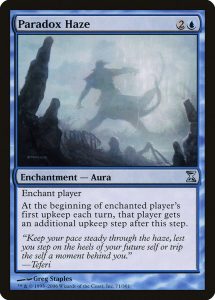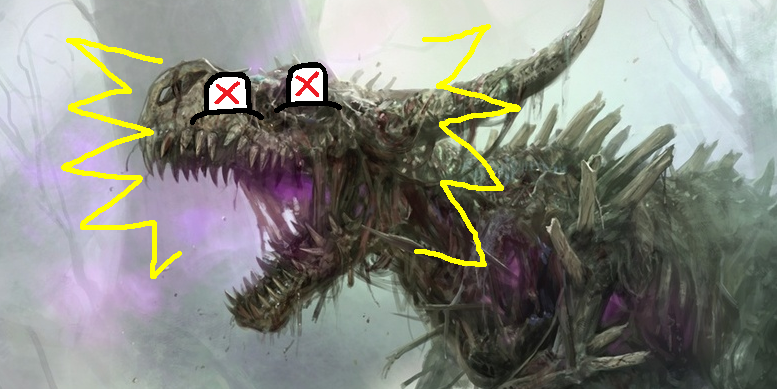Hey there! I’m Scott from the top four of last year’s Great Designer Search 3. Welcome back to another installment of Deadly Designs, where we talk about Magic card design from an outsider’s perspective.
Last time we used our powers of deduction to try and predict the mechanics in the upcoming Throne of Eldraine set. But this time I want to pose a question: is the upkeep step going extinct?
Paradox Haze says: “Uh, I hope not…”

First, you might be wondering two things: “why would you bother thinking about this?” and “who cares?”
So let’s take a look at both those questions, starting with part one, the inspiration behind this question: evidence of the upkeep step becoming extinct.
Part One: The Evidence
#1. GDS3
During GDS3, I submitted a blue/white planeswalker card as part of the design test. Here it is in all of its mediocre glory:

And then here’s what Ethan Fleischer, winner of GDS2 and one of the judges, had to say about it:
“The plus ability here is extremely narrow in application, only really doing anything with cards that trigger during your upkeep or at the beginning of your main phase. This is more narrow than I would want to put on a planeswalker. I’m generally not in favor of shining a spotlight onto the increasingly irrelevant upkeep step.”
Hearing Ethan say that the upkeep step was becoming “increasingly irrelevant” shocked me a bit at first, but then I really thought about it.
Even though the upkeep was a pretty important step years ago, it’s become less and less important as Magic has evolved. Paying upkeep costs is much rarer now, and once-per-turn bonuses often happen during combat, end steps, or other times.
#2. Sagas
Ethan’s words were also particularly potent at that time, because it was right around when Dominaria had been released, and along with it the sagas, which basically give the cold shoulder to the upkeep step.
Not to mention “enters the battlefield” which just became “enters.”

The wording on the sagas of “after your draw step” instead of “at the beginning of your upkeep” made me think that the upkeep was already in danger of extinction.
Aside from The First Eruption which adds mana, any of the other saga abilities could have just as easily triggered during the upkeep, and yet they didn’t. The designers made the conscious choice to use “after your draw step” instead.
Not that having the mana only during your upkeep would’ve
made The First Eruption any more unplayable….

#3. Upkeep Usage Decline
As a final piece of evidence for the upkeep becoming less relevant, let’s take a look at the number of times “upkeep” has appeared on cards in recent sets:
- Guilds of Ravnica: 1 time (Charnel Troll)
- Ravnica Allegiance: 9 times
- War of the Spark: 2 times (Davriel and Dreadhorde Invasion)
- M20: 2 times (Mythic Chandra and Rotting Regisaur)
That’s a grand total of 14 cards out of 1093, or a very low 1.3 percent. Is having an entire step, something that players have to learn and that has to be remembered every game, worth it for 1.3 percent of cards in the last year?
To find out, let’s take a look at what the consequences could be if the upkeep went away.
Part Two: What If?
First, let’s make it clear that we’re not talking about removing the upkeep, but rather replacing it. Just like how “remove from the game” turned into “exile,” or “comes into play” turned into “enters the battlefield,” similarly “at the beginning of your upkeep” would turn into “after your draw step” (or something equivalent).
#1. Less Steps, Less Words
As the game grows, some things have to leave in order to make room for new additions. Many rules have changed over Magic’s history, some fairly recently including the London mulligan, the planeswalker uniqueness rule, redirection of damage to planeswalkers, mana burn, combat damage on the stack, and more.
Removing the upkeep step isn’t a huge reduction of the game’s complexity, but it is something. Instead of beginners having to learn “untap, upkeep, draw,” instead they would only have to learn “untap, draw.” I know it’s always awkward when I teach someone new the game and explain to them that the upkeep is a step that most of the time does nothing. Cutting it could alleviate the issue.
Also, “after your draw step” is a lot shorter than “at the beginning of your upkeep.” It’s 2 words and 8 letters shorter, meaning less text on cards. The shortness of the phrase is one of the reasons sagas used the new text, since otherwise the text would be hard to fit in the box. The shortened “after your draw step” might do the same for other new cards too.
For example, Amplifire is currently 8 lines of text line, pretty much the limit for a printable card. With the shortened text, it might’ve had room for trample or something else.

#2. Some Better, Some Worse
Of course, changing the timing of the “upkeep” would have a tangible effect on certain cards. While many upkeep triggers wouldn’t really be affected, some of them would, especially cards that make you discard as an upkeep cost.

If “at the beginning of your upkeep” was replaced with “after your draw step,” then Masticore (and cards like it) would get better, since you get to draw before you discard.
However, Rotting Regisaur (and cards like it) would get worse, since you have to draw before you discard, forcing you to always discard a card instead of ignoring the upkeep cost when you have an empty hand.
Since some cards would get better and some would get worse, I feel like the change would mostly be a wash. Although I do give a slight advantage to making the change, since having to pay upkeep costs before you draw and before you have full information for your turn isn’t a ton of fun.
For example, knowing what you’re going to draw for the turn before choosing to pay Avalance Rider’s echo cost would lead to better turn planning.

#3. Strategic Changes
Finally, there could be some strategic changes that come from removing the upkeep. For example, take a look at this board state:

It’s your turn, playing mono-red against mono-blue. You just drew a shock for your turn. You have to shock the Merfolk Trickster, but when is the ideal time to shock it?
With the upkeep step, the ideal time is to cast shock during the upkeep. If they have a counterspell, they waste their mana for the turn. And if they don’t have a counterspell, you do it before they have a chance to draw into one.
It’s strictly the correct decision to cast it during the upkeep. However, is a “strictly best” decision the most interesting?
Imagine there were no upkeep step. Then you would have to weigh the pros and cons of casting the shock during your turn (when they have one less card), or during your opponent’s turn (when they waste their mana for the turn). There would be no window to get the best of both worlds.
This reminds me of when damage was removed from the stack. It was almost always “strictly best” to stack damage, then sacrifice a creature that had a sacrifice ability. Lots of cards got worse when stacked combat damage went away because of this, but it opened up some strategic depth. Do you sacrifice your creature to get its ability? Or do you let it deal its combat damage instead? What used to have a “strictly best” answer suddenly became a lot more interesting and context dependent.
It used to be you could block a 1/1 with your Mogg Fanatic, stack its combat damage, and ping the opponent too. But now you have to pick one or the other, opening up strategy.

Personally, I’m neither for or against the extinction of the upkeep step. I do think removing it would open up some interesting paths, but there might be more ramifications than what we’ve covered here.
However, I would not be surprised at all to see in a future set announcement that the upkeep is going the way of mana burn.
What do you think? Is the upkeep a sacred cow, or should it be slaughtered?
